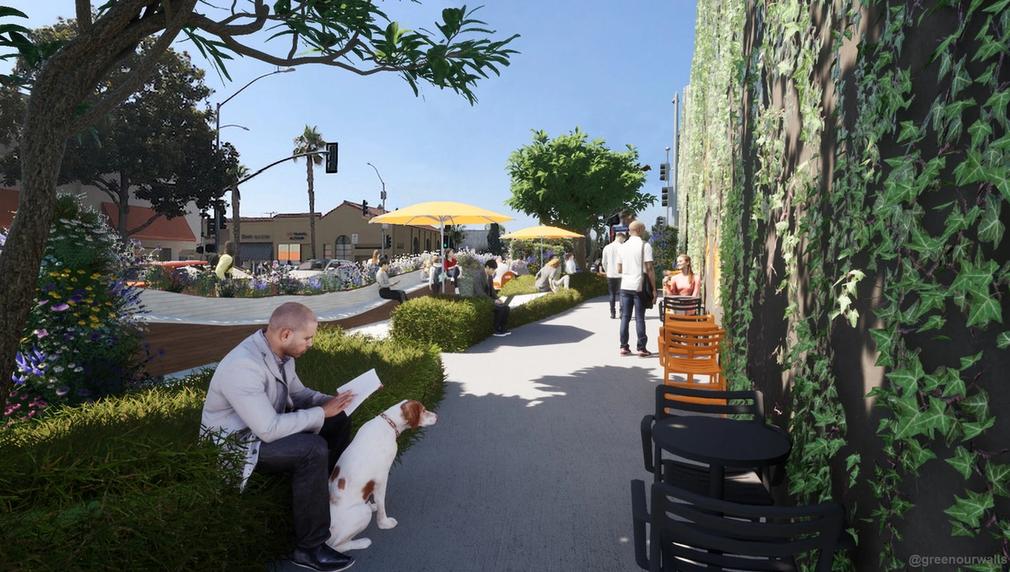The Green Our Walls Initiative (GOWI): Green Corridors + Hubs
The project aims to give voice to a neighborhood facing urban decay and exclusion by implementing the first of three green corridor/hub sites. Community workshops focused on co-design and creative placemaking will transform a distressed street into a vibrant public space. It aims to create a safe and sustainable space developed by and for local neighborhoods. The goal is to enhance wellbeing, and social health while fostering deeper connections to nature ultimately creating a greener, more welcoming Los Angeles County.

What is the primary issue area that your application will impact?
Green space, park access, and trees
In what stage of innovation is this project, program, or initiative?
Pilot or new project, program, or initiative (testing or implementing a new idea)
What is your understanding of the issue that you are seeking to address?
LAC is car-centric, lacking tree canopy and urban greening resulting in miles of the built environment experienced as devoid of pedestrian activity. Walkable spaces readily accessible between home, work/study and daily activities are nonexistent for most. Pedestrian-friendly neighborhoods, where people of all ages feel safe, happy and welcome, are particularly rare in under-resourced communities. Neglect, decay, poor lighting conditions, long walking distances further urban inertia, increased crime and contributes to loss of community identity and pride, wellbeing and urban loneliness. Lack of public seating impacts the way people live and relate to one another. Likewise, the absence of trees and plant life undermines health, sustainability and the way people relate to one another, their immediate environments and climate. Design, use and perceptions impact access, agency and safety in public spaces. A multifaceted approach fostering social health and supportive environments is needed.
Describe the project, program, or initiative this grant will support to address the issue.
Green corridors/hubs will start small and scale up into a network of urban micro-parks, individually serving neighborhoods of approximately 1,000 people and located within a ½ mile/15 minutes from parks, schools, transit stops, or other services. A single hub where all are heard and seen by others will be located in an empty lot or between buildings, while others may occupy spaces equivalent to 2-3 parking spots. Green corridors/hubs will renew degraded or neglected areas. This necessitates the consideration of the day-to-day experiences of people who live in or frequent the neighborhood. Urban greening, local art and murals contribute to both the actual and perceived safety and stability of a neighborhood by reflecting and reinforcing community identity. We are committed to participatory design and considering ways we could lift women and girls, minorities and other disadvantaged groups. Neighborhood collaborations and blending art, culture, and greenery will express the community's values and way of life. Each hub will be co-designed with the community and feature green walls or vertical gardens, at least one fruit-bearing tree, a canopy to provide shelter from the elements, bicycle racks, benches for resting, a drinking fountain, ample lighting, a little free library, free WIFI and will serve as a neighborhood emergency hub during disasters. Hydroponic gardens, climbing vines, shrubs, and other native plants that attract pollinators are integral to the success of the GOWI.
Describe how Los Angeles County will be different if your work is successful.
Green Corridors/Hubs is a duplicatable model that can be implemented in other municipalities. LAC will benefit from enriched neighborhood spaces and experiences and by encouraging community-led initiatives to co-create norms and standards that enhance access, safety, and participation.
Green Corridors/Hubs improve concrete sidewalk infrastructure, walkability and quality of life. They Are alive, adaptive and life-affirming, and deepen our connection to our natural and built environment while imparting pleasure and wellbeing. They decrease heat island effect, increase biodiversity and livability in urban communities, while adding oxygen to the air, removing carbon dioxide from the atmosphere.
Thriving neighborhoods contribute to a safer and more sustainable urban environment benefiting both individuals and the broader community. This values-led urban community-based re-designing process conjoins social change, the environment and design in order to improve wellbeing and sustainability.
What evidence do you have that this project, program, or initiative is or will be successful, and how will you define and measure success?
GOWI is committed to promoting open data, sustainability, and equity through rigorous impact assessments and audits. For example, Environmental and Sustainability Impact Assessments will measure the reduction of the heat island effect. Gender and Social Inclusion Assessments will emphasize user viewpoints via field observations highlighting lived experience, the conditions and challenges of each site. Participants will be asked to evaluate the sites based on their feelings of equity, beauty, safety and security. They will share their movements and experiences en route to/from the sites. Pre and post audits will allow nuanced understanding of the community’s concerns and needs as they move around their neighborhoods. Safety and sustainability apps have been used in a number of cities around the world over the past decade in diagnosing local issues. We hope to work with city stakeholders to implement interventions, but also to measure the impact of interventions.
Approximately how many people will be impacted by this project, program, or initiative?
Direct Impact: 500.0
Indirect Impact: 1,500.0